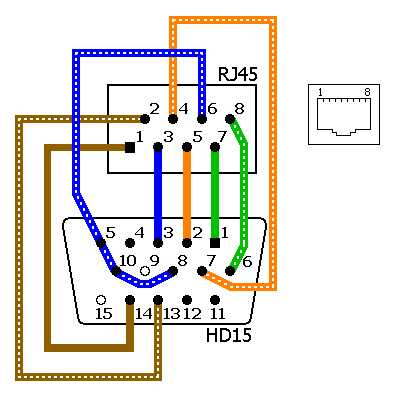I have written about sending video signals over UTP cable. I have covered single composite video signal and audio. Now it is time to discuss sending VGA over UTP cable.
Some DIY people (including me) have built different kind of adapters from VGA connector to RJ-45 connector. In best cases simple passive connection between those connectors works somehow acceptably, often especially on longer runs not. The problems are related to impedance matching and electromagnetic interference issues. Generally if you want to run VGA signal straight to CAT5 or better cable, use shielded cable, because it will work better than unshielded!
VGA over Cat-5 ethernet cable web page provides this plan for VGA to RJ-45 connection:
Make your own VGA cord of CAT5 cable! gives plans based on pretty much the same idea. There are also commercial adapters available based on similar idea.
The proper way for VGA-RJ45 that is more guaranteed to give better results is more complicated. Transmitting video over CAT5 cable article presents the most current design methods for transmitting high bandwidth SXGA video signal over long distances of Cat 5 cable (300m or more). Typically, signals originate in single ended rather than differential form. Converting a single ended signal to differential mode prior to line transmission reaps the benefit of high common mode noise reduction. Differential line receiver receives a differential voltage, reduces the common mode input gain to zero and terminates in a single ended output.
Because doing all the needed conversions for proper VGA to UTP adaption takes quite a lot of components if done with discrete parts, there are special ICs designed for this application also. EL4543 is a high bandwidth triple differential amplifier with integrated encoding of video sync signals. The high bandwidth enables differential signalling onto standard twisted-pair or coax with very low harmonic distortion, while internal feedback ensures balanced gain and phase at the outputs reducing radiated EMI and harmonics. Embedded logic encodes standard video horizontal and vertical sync signals onto the common mode of the twisted pair(s), transmitting this additional information without the requirement for additional buffers or transmission lines.
When you have balancing and impedance matching handled, there are still issues, especially on longer run. One is color drift. UTP Cable and Colour drift article tells that colour drift shows up as that annoying coloured shadow you occasionally see around objects on a video screen. It sometimes happens with UTP cable because the pairs of wire in the cable are twisted a slightly different rates to reduce crosstalk between pairs. UTP cable varies widely by manufacturer, so before installing video extenders it’s difficult to determine whether or not you’re going to have a colour drift problem. You’re more likely to experience colour drift whith higher grades of cable (CAT5e or CAT6), on longer cable runs, and on high-resolution screens. A video skew compensator (more expensive electronics) can be used to remove colour drift by delaying some colour signals to compensate for differences in wire pairs.
If you need to transport VGA picture over very long distances, then one option is to use some hardware (KVM-over-IP) or software (for example VNC) that converts VGA signal to IP data that can be transported over Ethernet LAN (or fast Internet connection).


1 Comment
Seule Chaudasse says:
C’est un vrai plaisir de lire ce poste